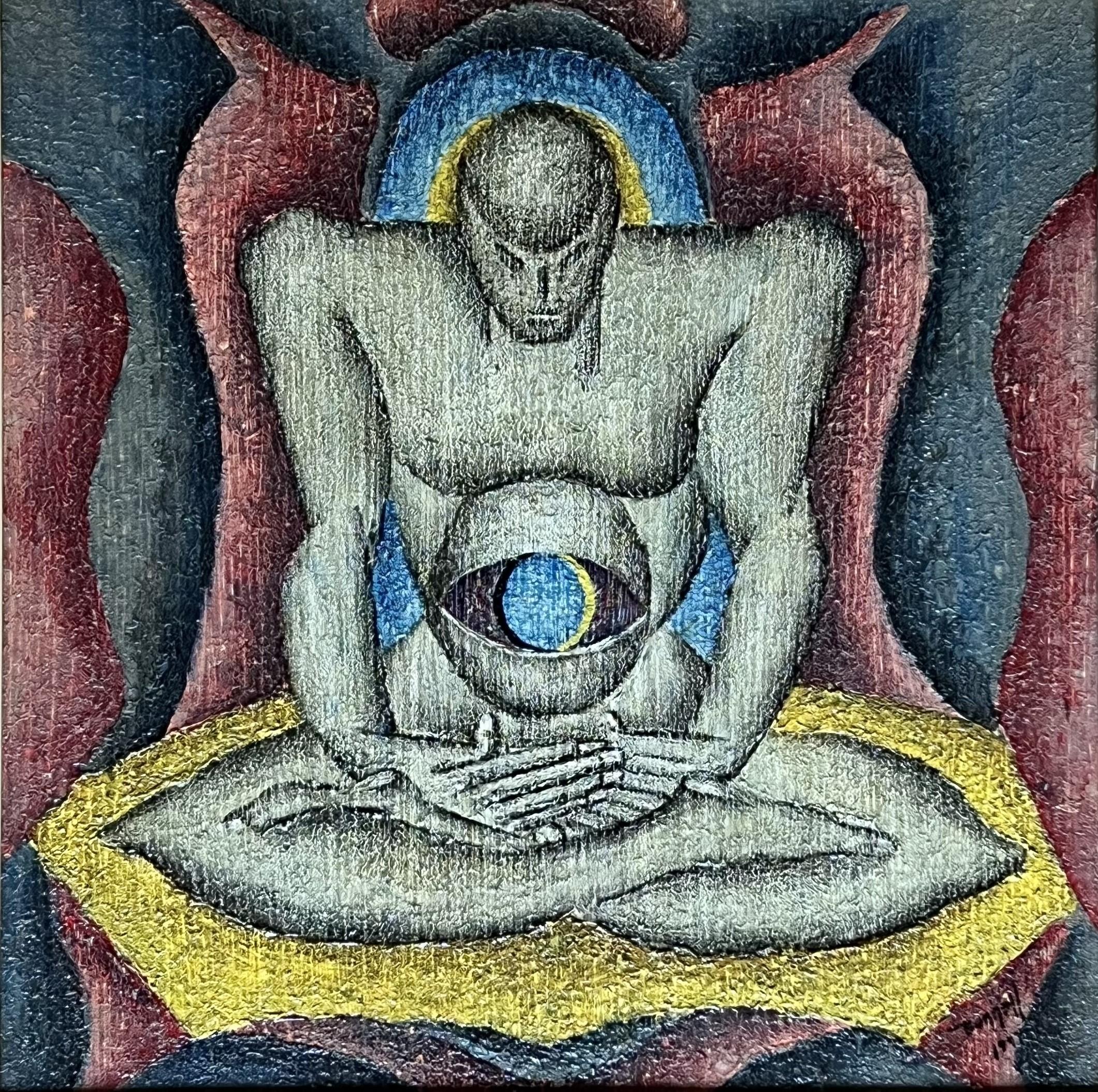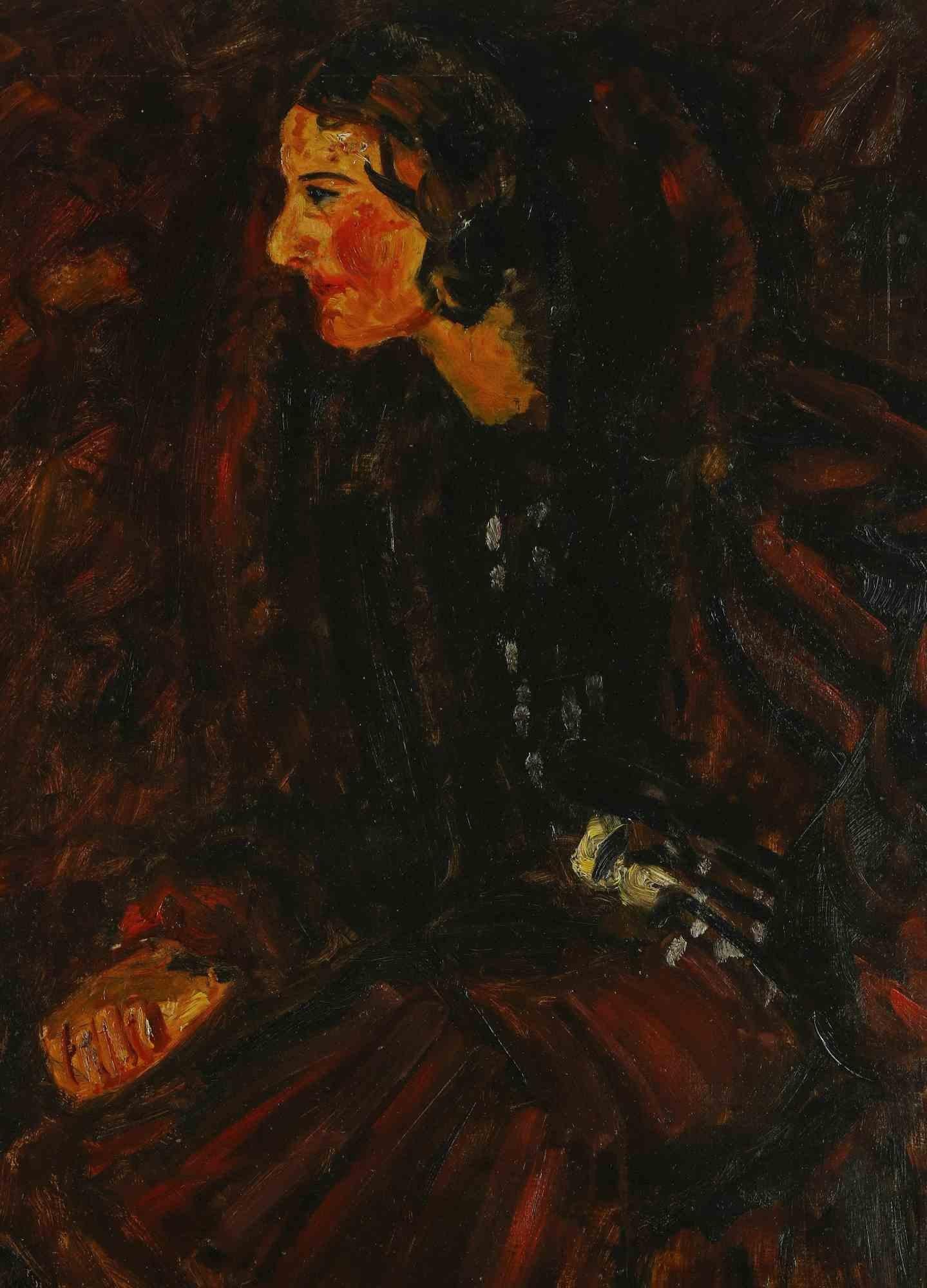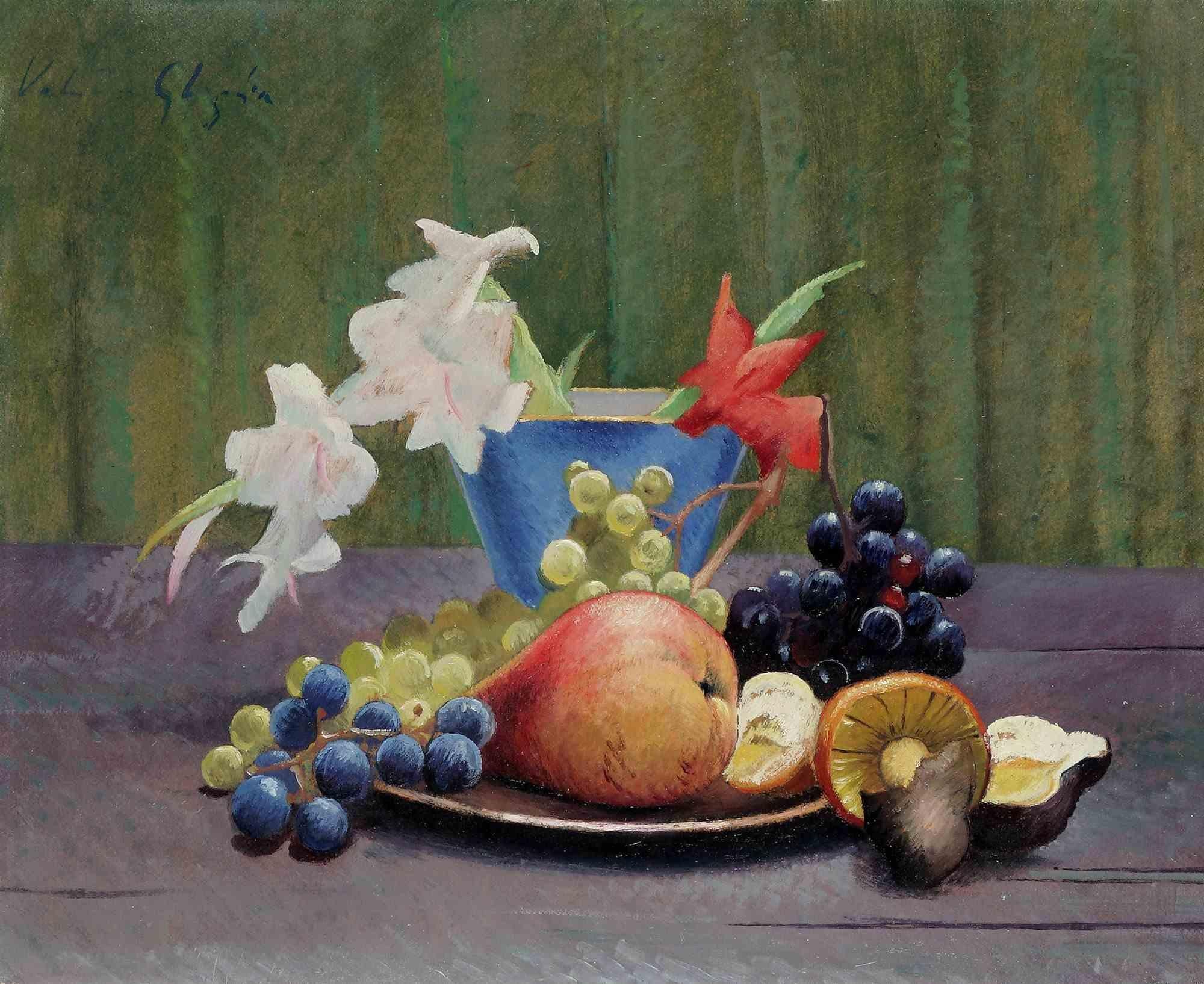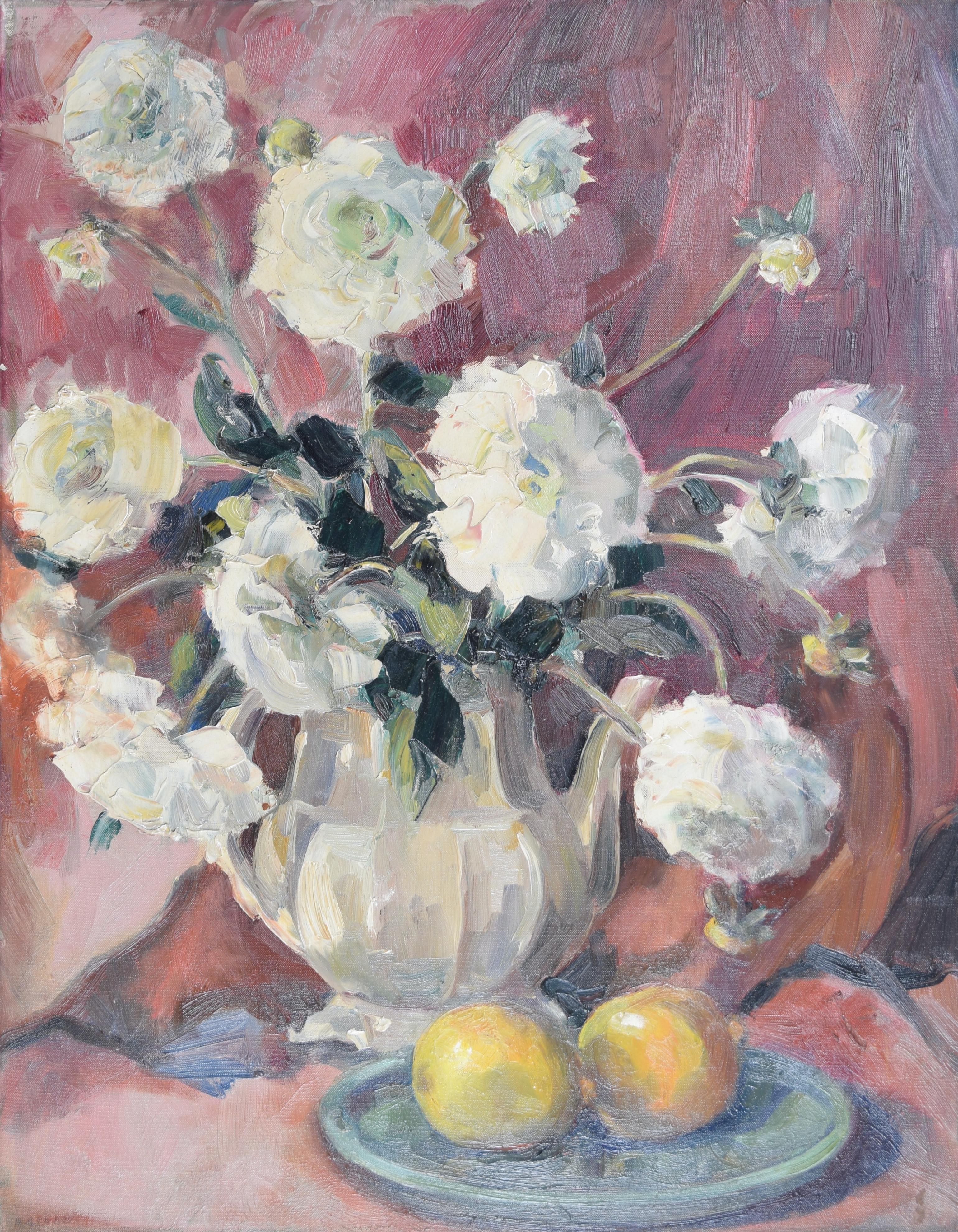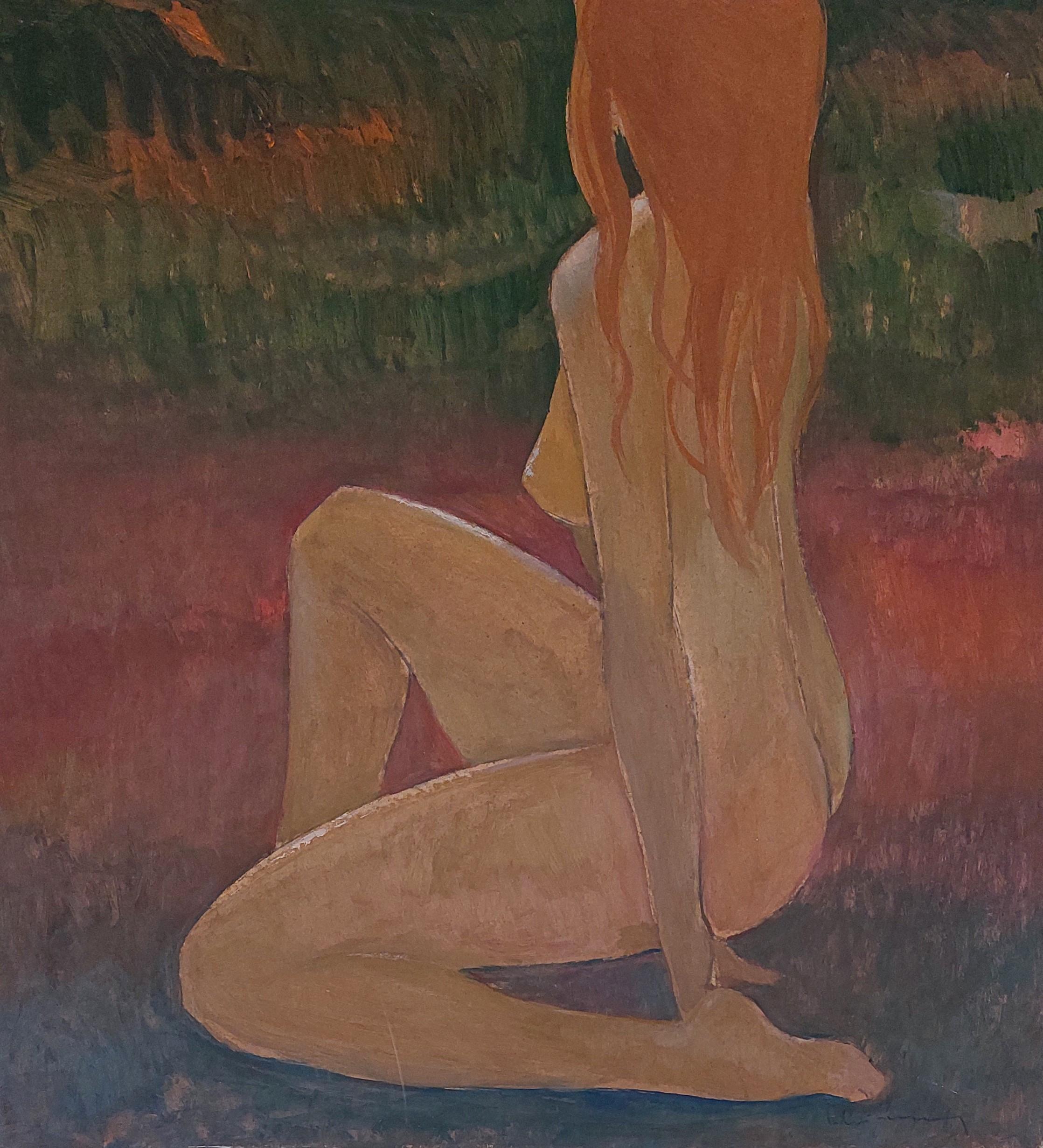Items Similar to Large American Modernist Judaica Oil Painting Rabbinic Discussion
Want more images or videos?
Request additional images or videos from the seller
1 of 11
Ervin B. NussbaumLarge American Modernist Judaica Oil Painting Rabbinic Discussion
About the Item
Ervin B. Nussbaum was born in Columbus, Ohio on November 11, 1914. His father, Marger, had arrived as part of the great Russian Diaspora of the time, when many Jewish families settled in Ohio, particularly in the Columbus area.
Nussbaum attended Ohio State University during the Great Depression and continued to live in Ohio until America’s involvement in World War II. His oil painting The End of John Brown, which depicts a fictionalization of the American abolitionist’s final hours, won first prize at the Central Ohio Competition in 1941. The piece then toured the country stopping at the San Francisco Museum, the Butler Art Institute, the Philadelphia Academy and the Corcoran Gallery. Donated in 2001, the painting is now part of the permanent collection at the Torrington Historical Society in Torrington, Connecticut, John Brown’s birthplace.
When the war began, Ervin, along with some 40,000 other men of all faiths, became part of the conscientious objector program known as the Civil Public Service. He spent the years 1942 through 1946 interned in government camps from New Hampshire to Maryland, working in public services such as forestry and hurricane cleanup. Many other objectors housed alongside him were of artistic inclination and shared Nussbaum’s conviction of peace, so artistic pursuits were common within these camps.
During these early years, his paintings followed a somewhat whimsical figurative style and leaned towards patriotic and Hebraic themes. In time, these themes began to take on an almost Cubist feel and eventually leaned toward complete abstraction.
Upon his release from his voluntary conscription as a CPS, Nussbaum moved to New York where he frequently painted semi-abstract landscapes in the local parks, throughout the New England countryside, and at the shorelines. He especially enjoyed painting in the woodland tranquility of Inwood Park in northern Manhattan. He paid special attention to the park’s bird life, which would soon become a new favorite subject. Their graceful movement inspired his creation of a series of avian sculptures in wood, metal or mixed medias.
In 1951, he met the dynamic young actress, playwright, musician, and graphic artist Muriel Leventhal. They married and moved to Norwalk, Connecticut in 1959. Nussbaum continued to work in a variety of media and showed regularly in many different galleries throughout Connecticut. His bronze sculptureThree Girls on a Flower was commissioned by the Trumbull Library and a wood bas-relief was created for the sanctuary at the Yonkers Temple Emanuel. Nussbaum would remain in Norwalk until his death in 1996.
When contemplating the work of Ervin Nussbaum, we find the soul of a man set in principles of profound religious and patriotic convictions as well as a deep abiding love of nature. His art shows us the evolution of the man through the evolution of the styles he undertook during his lifetime; from figurative, to cubist, to complete abstraction; from oils, to charcoal, to a mixture of media. His works are left to us in museums across the United States, as well as in countless private collections in the U.S. and abroad.
- Creator:Ervin B. Nussbaum (1914-1996, American)
- Dimensions:Height: 48 in (121.92 cm)Width: 30 in (76.2 cm)
- Medium:
- Movement & Style:
- Period:
- Condition:Minor wear, small area of imperfection in canvas. selling unframed.
- Gallery Location:Surfside, FL
- Reference Number:1stDibs: LU38210806572
About the Seller
4.9
Platinum Seller
These expertly vetted sellers are 1stDibs' most experienced sellers and are rated highest by our customers.
Established in 1995
1stDibs seller since 2014
1,556 sales on 1stDibs
Typical response time: 1 hour
- ShippingRetrieving quote...Ships From: Surfside, FL
- Return PolicyA return for this item may be initiated within 3 days of delivery.
More From This SellerView All
- Jewish Village Palestine/Israel C.1930s Modernist PaintingBy Ida Shelesnyak MirrofLocated in Surfside, FLBezalel School Period. Genre: Judaica Subject: People Medium: Oil Surface: Canvas Dimensions: 16" x 20"Category
Early 20th Century Modern Figurative Paintings
MaterialsOil, Board
- Bathers at the Quarry 1940s American Modernist Oil Painting WPA eraBy Theresa Berney LoewLocated in Surfside, FLSwimmers and sun tanners at the local watering hole. Her birth name was Theresa Berney. At the time of her passing she was known as Theresa Loew. Birth place: Baltimore artist, blo...Category
1940s American Modern Landscape Paintings
MaterialsOil, Board
- Oil Painting Interior Scene Chair w Chinese Rug Joseph Solman American Art WPABy Joseph SolmanLocated in Surfside, FLJoseph Solman (1909-2008), Chair with Chinese Rug, oil paint on masonite, initialed JS on recto, titled and signed "J.S." verso, Dimensions 14" x 10" Framed to 21 X 17 Provenance...Category
20th Century Modern Interior Paintings
MaterialsOil, Board
- Blessing the New Moon, Judaica, Oil PaintingBy Simon Natan KarczmarLocated in Surfside, FLSimon Karczmar, Polish (1903 - 1982) Born in Warsaw, Poland, in 1903, Simon Karczmar studied art in Paris, where he lived for twenty years. Although he left France for Israel in 196...Category
20th Century Modern Figurative Paintings
MaterialsOil, Board
- LAKEWOOD N.J., 1936 Modernist Oil Painting, JudaicaBy Emanuel Glicenstein RomanoLocated in Surfside, FLGenre: Modern Subject: Landscape Medium: Oil Surface: Board Country: United States Dimensions: 30" x 22" EMANUEL ROMANO Rome, Italy, b. 1897, d. 1984 Emanuel Glicenstein Romano was born in Rome, September 23, 1897. His father Henryk Glicenstein was a sculptor and was living in Rome with his wife Helena (born Hirszenberg) when Emanuel was born. His father obtained Italian citizenship and adopted the name Enrico. Emanuel was brought up in Italy, Switzerland, Germany, England and Poland. In 1926 Emanuel and his father sailed for New York. They briefly visited Chicago. Romano's sister, Beatrice, and mother only joined them in New York years later. Romano changed his name on his arrival to America and some have erroneously speculated that this was to avoid antisemitic discrimination. In truth, as the son of a highly-regarded artist, Romano changed his name to ensure that any success or recognition he would later attain, would be the result of nothing other than his own merit as an artist, and not on account of his father's fame. In 1936 Romano was worked for the Federal Art Project creating murals. During and immediately after World War II, Romano created a series of allegorical works depicting graphic holocaust images that were held closely by the family until after his passing. One of these works is now on permanent display in the Florida Holocaust Museum in St. Petersburg Florida. Emanuel's father died in 1942 in a car accident before they could realize their shared dream of visiting Israel. In 1944 Romano, having completed his degree at the Pennsylvania Academy of Fine Arts and the Art Institute of Chicago, began teaching at the City College of New York. Romano moved to Safed, Israel in 1953 and established an art museum in his father's memory, the Glicentein Museum. COLLECTIONS Indianapolis Museum of Art Metropolitan Museum of Art Boston Fine Arts Museum Fogg Museum Musée Nacional de France Recently his work has been added to the Florida Holocaust Museum collection. His notable works include his holocaust themed allegorical paintings as well as portraits of Marianne Moore, his father and William Carlos...Category
1930s American Modern Figurative Paintings
MaterialsOil, Board
- Large Modernist Oil Painting 1940s, Judaica Hasidic Shtetl Wagon Driver WPA EraBy Emanuel Glicenstein RomanoLocated in Surfside, FLGenre: Modern Subject: Landscape with figure of horse, driver and wagon Medium: Oil Surface: wood Board EMANUEL ROMANO Rome, Italy, b. 1897, d. 1984 Emanuel Glicen Romano was born in Rome, September 23, 1897. His father Henryk Glicenstein was a sculptor and was living in Rome with his wife Helena (born Hirszenberg) when Emanuel was born. His father obtained Italian citizenship and adopted the name Enrico. Emanuel was brought up in Italy, Switzerland, Germany, England and Poland. In 1926 Emanuel Glicenstein Romano and his father sailed for New York. They briefly visited Chicago. Romano's sister, Beatrice, and mother only joined them in New York years later. Romano changed his name on his arrival to America and some have erroneously speculated that this was to avoid antisemitic discrimination. In truth, as the son of a highly-regarded artist, Romano changed his name to ensure that any success or recognition he would later attain, would be the result of nothing other than his own merit as an artist, and not on account of his father's fame. In 1936 Romano was worked for the WPA Federal Art Project creating murals. ( there were many jewish artists active with in the WPA period. notably Chaim Gross, Ben Shahn, Isaac and Moses Soyer, Abraham Rattner and many others. During and immediately after World War II, Romano created a series of allegorical works depicting graphic holocaust images that were held closely by the family until after his passing. One of these works is now on permanent display in the Florida Holocaust Museum in St. Petersburg Florida. Emanuel's father died in 1942 in a car accident before they could realize their shared dream of visiting Israel. In 1944 Romano, having completed his degree at the Pennsylvania Academy of Fine Arts and the Art Institute of Chicago, began teaching at the City College of New York. Romano moved to Safed, Israel in 1953 and established an art museum in his father's memory, the Glicenstein Museum. COLLECTIONS Indianapolis Museum of Art Metropolitan Museum of Art Boston Fine Arts Museum Fogg Museum Musée Nacional de France Recently his work has been added to the Florida Holocaust Museum collection. His notable works include his holocaust themed allegorical paintings as well as portraits of Marianne Moore, his father and William Carlos Williams...Category
1930s American Modern Figurative Paintings
MaterialsOil, Board
You May Also Like
- Untitled (Transcendental Composition)By Charles Ragland BunnellLocated in Los Angeles, CAThis work is part of our exhibition - America Coast to Coast: Artists of the 1940s Untitled (Transcendental Composition), oil on board, 1947, oil on board, signed and dated lower r...Category
1940s American Modern Paintings
MaterialsOil, Board
- Woman - Oil Painting on Canvas by Antonio Feltrinelli - 1920sLocated in Roma, ITWoman is an orignal modern artwork realized by Antonio Feltrinelli in 1920s. Mixed colored oil painting on board. Not signed. Antonio Feltrinelli (Milan, 1887 – Gargnano, 1942) H...Category
20th Century Modern Figurative Paintings
MaterialsBoard, Oil
- Still Life - Oil on Cardboard by Valentino Ghiglia - Mid-20th CenturyBy Valentino GhigliaLocated in Roma, ITStill Life is an artwork realized by Valentino Ghiglia in the Mid-20th Century. Oil on Cardboard, cm 46x57. Hand signed on top left. Very good condition.Category
Mid-20th Century Modern Still-life Paintings
MaterialsOil, Cardboard, Paper
- Russian Musicians - Oil painting by L. M. Brailovsky - Early 20th CenturyLocated in Roma, ITRussian Musicians is an original painting, realized by Leonid Mikhailovich Brailovsky in the Early XX century Oil painting on board. Hand-signed by the artist on the lower margin. I...Category
Early 20th Century Modern Figurative Paintings
MaterialsOil, Board
- Angela Stones: Still Life with Fruit and Flowers mid-20th century oil paintingBy Angela StonesLocated in London, GBTo see our other Modern British Art, scroll down to "More from this Seller" and below it click on "See all from this Seller" - or send us a message if you cannot find the artist you ...Category
20th Century Modern Figurative Paintings
MaterialsBoard, Oil
- Girl with red hair. 1996. Oil on cardboard, 90x83 cmLocated in Riga, LVGirl with red hair. 1996. Oil on cardboard, 90x83 cm This depiction of young nude woman with red hair on green-pink-blue background shows the artist as a master of forms and color field areas. Laimdots Murnieks...Category
Late 20th Century Modern Figurative Paintings
MaterialsCardboard, Oil
Recently Viewed
View AllMore Ways To Browse
American Art Paintings Of New England
Civil War America
Early Modernist Painting
Figurative Modernist Painting
Large Metal Paintings
Library Oil Painting
American Government
Oil Paintings Men
Maryland Painting
Russian Large Paintings
Large Flowers Oil Painting
House In Woods American Paintings
Large Peace Of Art
Depression Painting
Religious Figurative Paintings
Civil War Painting
Jewish Oil Painting
20th Century Abstraction Oil Paintings
